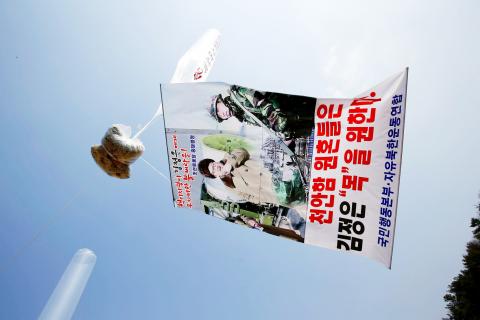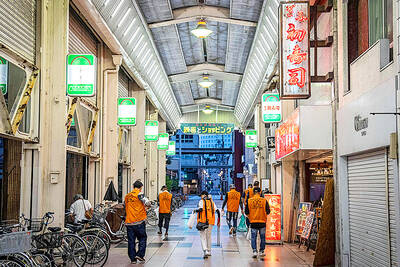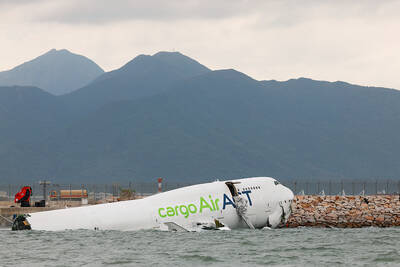South Korean activists launched tens of thousands of anti-Pyongyang leaflets into North Korea yesterday, amid heightened tensions on the divided Korean Peninsula, using a propaganda tool that usually sparks threats of reprisals.
Conservative activists, including many North Korean defectors, have been carrying out leafleting exercises using giant gas-filled balloons for years.
Defector-turned-activist Sanghak Park and his colleagues released 50,000 leaflets tied to three large balloons from an empty field near Paju City close to the border with North Korea, marking the sixth anniversary of the sinking of a South Korean warship with the loss of 46 sailors.

Photo: EPA
Seoul pinned the blame for the sinking on North Korea and froze trade and investment ties.
One of the three balloons was strung with a large banner printed with a Pyongyang-published picture of North Korean leader Kim Jong-un smiling against the backdrop of a missile being assembled.
“Bring down a firestorm on nuclear maniac Kim Jong-un,” the slogan read.
“We plan to launch a total of 10 million leaflets into the North over the next three months condemning North Korea’s nuclear tests,” Park told journalists.
In October 2014, North Korean frontier guards attempted to shoot down a set of such balloons, triggering a brief exchange of fire across the border.
Park and other activists face protests by residents and merchants living near the border, who are concerned that their livelihood might be affected.
Since North Korea’s fourth nuclear test on Jan. 6, South Korea has resumed blasting a mix of K-pop and propaganda messages into North Korea, using giant banks of speakers on the heavily militarized border.
North Korea has responded by dropping its own leaflets over the border, attacking South Korean President Park Geun-hye and returning to psychological warfare methods used in the 1950s and 1960s.

A missing fingertip offers a clue to Mako Nishimura’s criminal past as one of Japan’s few female yakuza, but after clawing her way out of the underworld, she now spends her days helping other retired gangsters reintegrate into society. The multibillion-dollar yakuza organized crime network has long ruled over Japan’s drug rings, illicit gambling dens and sex trade. In the past few years, the empire has started to crumble as members have dwindled and laws targeting mafia are tightened. An intensifying police crackdown has shrunk yakuza forces nationwide, with their numbers dipping below 20,000 last year for the first time since records

EXTRADITION FEARS: The legislative changes come five years after a treaty was suspended in response to the territory’s crackdown on democracy advocates Exiled Hong Kong dissidents said they fear UK government plans to restart some extraditions with the territory could put them in greater danger, adding that Hong Kong authorities would use any pretext to pursue them. An amendment to UK extradition laws was passed on Tuesday. It came more than five years after the UK and several other countries suspended extradition treaties with Hong Kong in response to a government crackdown on the democracy movement and its imposition of a National Security Law. The British Home Office said that the suspension of the treaty made all extraditions with Hong Kong impossible “even if

CAUSE UNKNOWN: Weather and runway conditions were suitable for flight operations at the time of the accident, and no distress signal was sent, authorities said A cargo aircraft skidded off the runway into the sea at Hong Kong International Airport early yesterday, killing two ground crew in a patrol car, in one of the worst accidents in the airport’s 27-year history. The incident occurred at about 3:50am, when the plane is suspected to have lost control upon landing, veering off the runway and crashing through a fence, the Airport Authority Hong Kong said. The jet hit a security patrol car on the perimeter road outside the runway zone, which then fell into the water, it said in a statement. The four crew members on the plane, which

Japan’s ruling Liberal Democratic Party (LDP) and its junior partner yesterday signed a coalition deal, paving the way for Sanae Takaichi to become the nation’s first female prime minister. The 11th-hour agreement with the Japan Innovation Party (JIP) came just a day before the lower house was due to vote on Takaichi’s appointment as the fifth prime minister in as many years. If she wins, she will take office the same day. “I’m very much looking forward to working with you on efforts to make Japan’s economy stronger, and to reshape Japan as a country that can be responsible for future generations,”